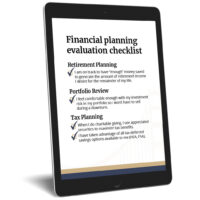
Department of Labor on ESG and private equity investing options for defined benefit plans
Do you, or do you want to, offer Environmental, Social and Corporate Governance (ESG) investment options in your qualified retirement plan? What about riskier private equity options? Here’s what’s on the Department of Labor (DOL)’s radar when it comes to both.
Environmental, Social and Corporate Governance (ESG) investing
While participant and plan sponsor interest in ESG investments has increased over the years, and more plans are offering ESG investments, the DOL has come out with a proposed regulation that leaves little room for doubt about where the current administration stands on the subject: fiduciaries must be able to justify the ESG investments on their financial merit when they are evaluated against non-ESG alternatives.
Duty of Loyalty
One of the tenets of ERISA’s fiduciary responsibility is the Duty of Loyalty, which requires that fiduciaries act solely in the interest of plan participants and beneficiaries, for the exclusive purpose of providing benefits to them. The DOL has previously stated that while ESG factors can be a tie-breaker consideration when comparing two otherwise equivalent investment options, the fiduciary cannot prioritize ESG criteria ahead of the merits of the investment. The new proposed regulation elaborates,
“The fundamental principle is that an ERISA fiduciary’s evaluation of plan investments must be focused solely on economic considerations that have a material effect on the risk and return of an investment based on appropriate investment horizons, consistent with the plan’s funding policy and investment policy objectives. The corollary principle is that ERISA fiduciaries must never sacrifice investment returns, take on additional investment risk, or pay higher fees to promote nonpecuniary benefits or goals.”
It makes no difference if the plan participants have clamored for ESG investments in the plan’s investment menu – the economic merit must come first. While this regulation may be modified before it becomes final, it is a signal to plan sponsors to proceed with caution when utilizing ESG options. Be prepared to defend the rationale for selecting and retaining the investments if the DOL comes to audit your plan.
What about private equity in retirement plans?
While ESG investing is not topping the DOL’s approved list, they recently issued an Information Letter outlining the considerations for plan sponsors to add private equity investments in qualified plans. Private equity managers are thrilled for a roadmap that provides them with the ability to tap into $9 trillion of retirement assets, but concerns remain about whether the use of these types of investments in defined contribution plans is truly in the best interest of participants.
Because private equity investments are illiquid and risky, they are typically available only to accredited investors—those with high net worth and income. Private equity investments include leveraged buyouts or venture capital investment into fledgling companies. They often come at a substantial cost, with management fees that may be in excess of 2% along with performance fees. The risks are significantly greater than those of the investments traditionally utilized in retirement plans; however, the potential reward of such investments can be sizeable if they succeed.
Managing the elevated risk of private equity
Private equity has long been utilized as a diversifier in defined benefit plans, where the plan sponsor invests to meet its financial obligations and assumes full responsibility for investment loss. The DOL letter describes the parameters for a plan sponsor to be able to add private equity to its 401(k) or other defined contribution plan menu, expanding the availability of such investments, and the associated risk, to ordinary investors.
While some see this move as a leveling of the playing field between the wealthy and the working class, others worry that private equity managers will be the real winners and participants will pay higher costs and experience more investment volatility. The letter prohibits the use of private equity as a standalone investment option in a menu of investments, but it describes how private equity can be incorporated into 401(k) plan’s professionally managed multi-asset-class investment options, such as the widely utilized target-date funds, risk-based funds, and balanced funds.
With the vast majority of 401(k) plans utilizing some form of managed portfolio solution, plan sponsors and their advisors must pay close attention to the components of these portfolio options to ascertain whether private equity is included and understand the associated risks. It may be some time before fund managers work through the operational challenges of holding illiquid investments in funds that must be valued daily, but we can expect that private equity will likely be coming to qualified retirement plans. Will you be ready?
If you have questions about your overall investment policy or ERISA Compliance, please reach out to us for a conversation.
The information provided herein is for informative and educational purposes only. The use of hyperlinks to third party websites is not an endorsement of the third party. Third party content has not been independently verified. To understand how this content may apply to you, please contact a financial advisor.






